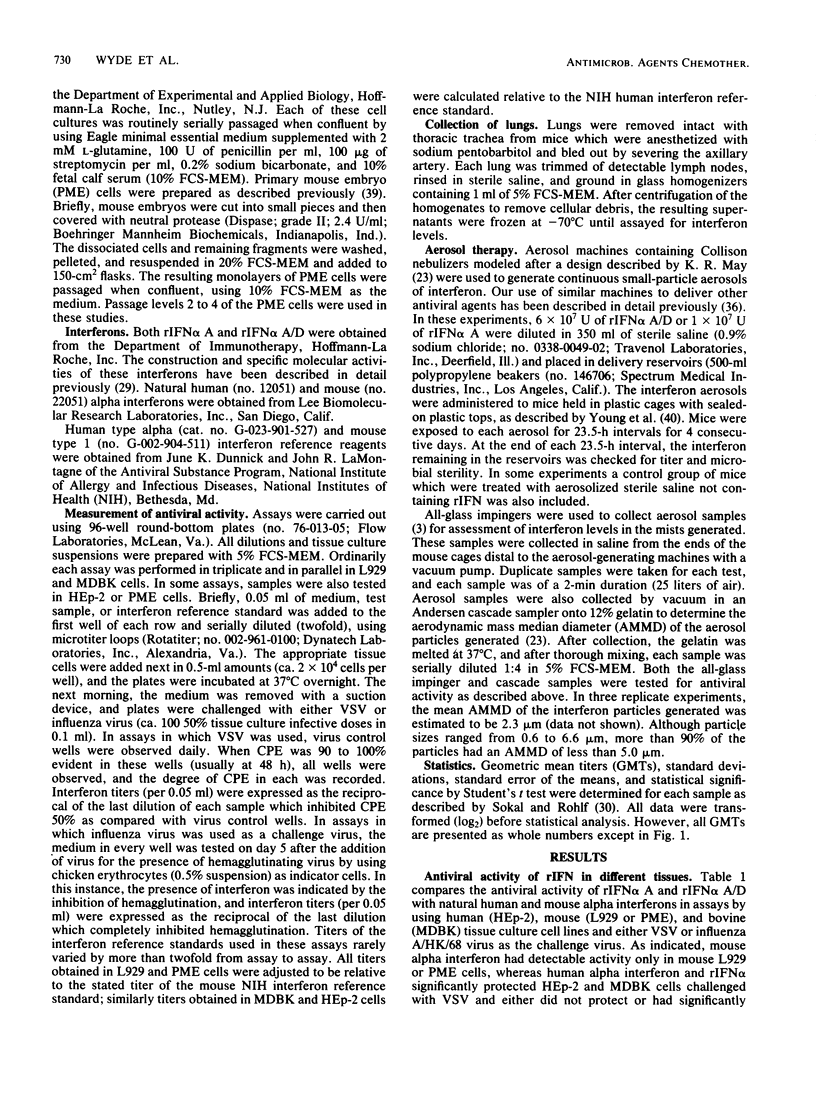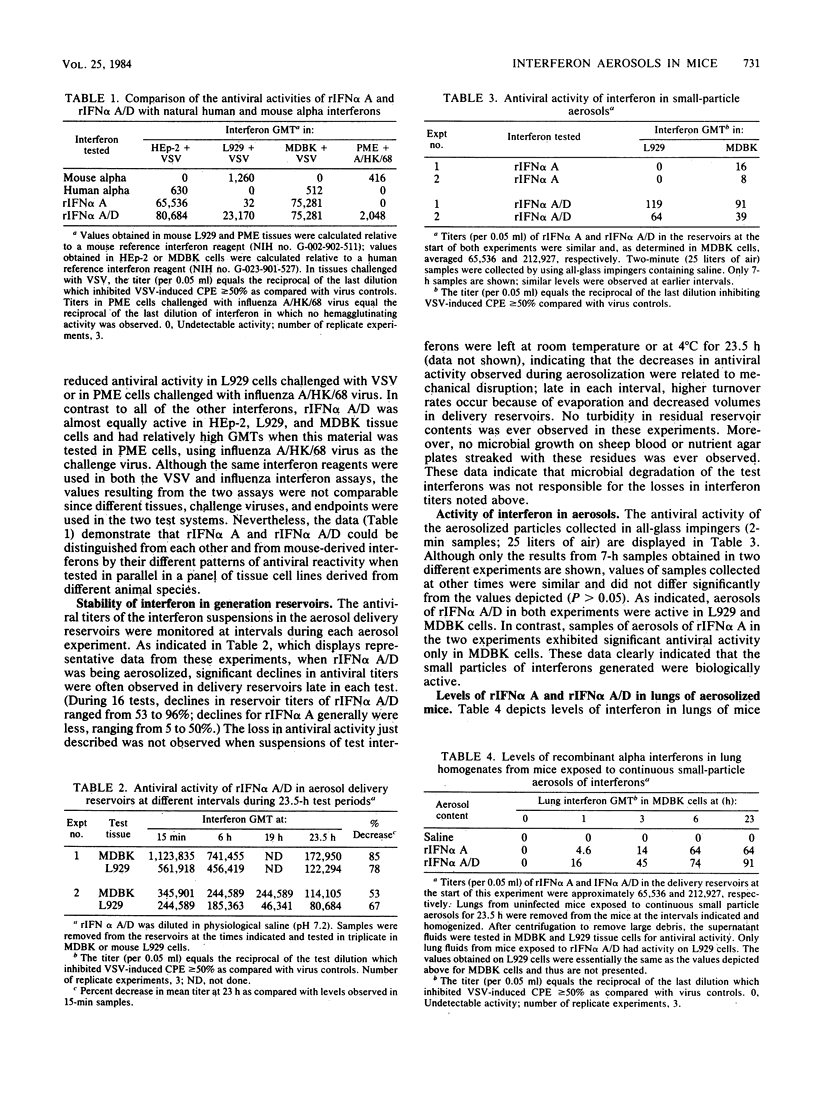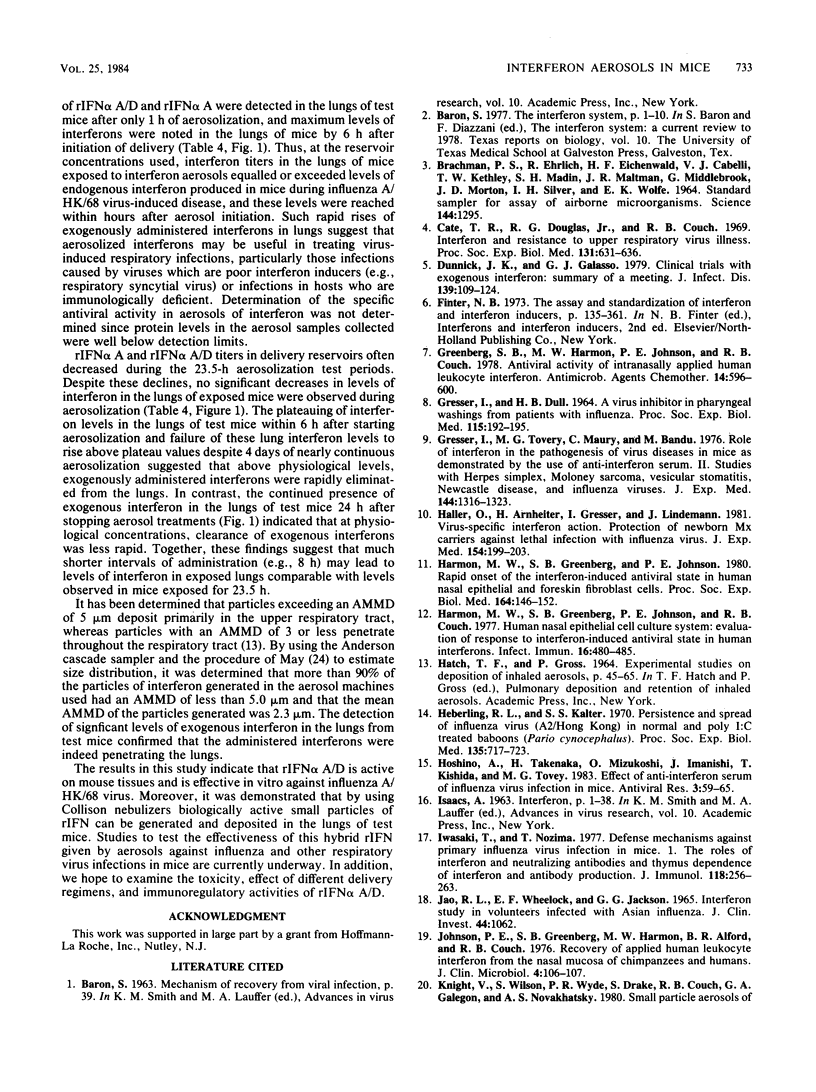Abstract
Small particle aerosols of a hybrid DNA recombinant human alpha interferon, A/D bgl, and a related DNA recombinant leukocyte interferon, A, were generated and delivered to mice for 23.5 h a day for 4 consecutive days. The antiviral activity of these interferons in delivery reservoirs, in the aerosols generated, and in the lungs of test mice was monitored during and after aerosol administration in cytopathic effect inhibition assays, using vesicular stomatitis virus as the indicator virus. In addition, the activity of these interferons in primary mouse embryo cells against influenza A/HK/68 (H3N2) virus was determined. The results obtained indicated that the interferon particles generated in the continuous aerosol therapy system used in these studies remained biologically active and could be readily detected in both aerosol mists and lungs of test mice; levels of exogenous interferon in the lungs equalled or exceeded levels of interferons produced endogenously during experimentally induced influenza virus infection. Titers of the exogenously administered interferons decreased gradually and disappeared from the lungs between 24 and 48 h after cessation of aerosolization. Recombinant human alpha interferon A/D, but not recombinant leukocyte alpha interferon A, significantly inhibited replication of A/HK/68 virus in primary mouse embryo cells in the in vitro studies.
Full text
PDF





Selected References
These references are in PubMed. This may not be the complete list of references from this article.
- Cate T. R., Douglas R. G., Jr, Couch R. B. Interferon and resistance to upper respiratory virus illness. Proc Soc Exp Biol Med. 1969 Jun;131(2):631–636. doi: 10.3181/00379727-131-33941. [DOI] [PubMed] [Google Scholar]
- Dunnick J. K., Galasso G. J. Clinical trials with exogenous interferon: summary of a meeting. J Infect Dis. 1979 Jan;139(1):109–123. doi: 10.1093/infdis/139.1.109. [DOI] [PubMed] [Google Scholar]
- GRESSER I., DULL H. B. A VIRUS INHIBITOR IN PHARYNGEAL WASHINGS FROM PATIENTS WITH INFLUENZA. Proc Soc Exp Biol Med. 1964 Jan;115:192–196. doi: 10.3181/00379727-115-28867. [DOI] [PubMed] [Google Scholar]
- Greenberg S. B., Harmon M. W., Johnson P. E., Couch R. B. Antiviral activity of intranasally applied human leukocyte interferon. Antimicrob Agents Chemother. 1978 Oct;14(4):596–600. doi: 10.1128/aac.14.4.596. [DOI] [PMC free article] [PubMed] [Google Scholar]
- Gresser I., Tovey M. G., Maury C., Bandu M. T. Role of interferon in the pathogenesis of virus diseases in mice as demonstrated by the use of anti-interferon serum. II. Studies with herpes simplex, Moloney sarcoma, vesicular stomatitis, Newcastle disease, and influenza viruses. J Exp Med. 1976 Nov 2;144(5):1316–1323. doi: 10.1084/jem.144.5.1316. [DOI] [PMC free article] [PubMed] [Google Scholar]
- Haller O., Arnheiter H., Gresser I., Lindenmann J. Virus-specific interferon action. Protection of newborn Mx carriers against lethal infection with influenza virus. J Exp Med. 1981 Jul 1;154(1):199–203. doi: 10.1084/jem.154.1.199. [DOI] [PMC free article] [PubMed] [Google Scholar]
- Harmon M. W., Greenberg S. B., Johnson P. E., Couch R. B. Human nasal epithelial cell culture system: evaluation of response to human interferons. Infect Immun. 1977 May;16(2):480–485. doi: 10.1128/iai.16.2.480-485.1977. [DOI] [PMC free article] [PubMed] [Google Scholar]
- Harmon M. W., Greenberg S. B., Johnson P. E. Rapid onset of the interferon-induced antiviral state in human nasal epithelial and foreskin fibroblast cells. Proc Soc Exp Biol Med. 1980 Jun;164(2):146–152. doi: 10.3181/00379727-164-40838. [DOI] [PubMed] [Google Scholar]
- Heberling R. L., Kalter S. S. Persistence and spread of influenza virus (A2-Hong Kong) in normal and poly I.C. treated baboons (Papio cynocephalus). Proc Soc Exp Biol Med. 1970 Dec;135(3):717–723. doi: 10.3181/00379727-135-35128. [DOI] [PubMed] [Google Scholar]
- Hoshino A., Takenaka H., Mizukoshi O., Imanishi J., Kishida T., Tovey M. G. Effect of anti-interferon serum of influenza virus infection in mice. Antiviral Res. 1983 Mar;3(1):59–65. doi: 10.1016/0166-3542(83)90015-3. [DOI] [PubMed] [Google Scholar]
- ISAACS A. INTERFERON. Adv Virus Res. 1963;10:1–38. [PubMed] [Google Scholar]
- Iwasaki T., Nozima T. Defense mechanisms against primary influenza virus infection in mice. I. The roles of interferon and neutralizing antibodies and thymus dependence of interferon and antibody production. J Immunol. 1977 Jan;118(1):256–263. [PubMed] [Google Scholar]
- Johnson P. E., Greenberg S. B., Harmon M. W., Alford B. R., Couch R. B. Recovery of applied human leukocyte interferon from the nasal mucosa of chimpanzees and humans. J Clin Microbiol. 1976 Jul;4(1):106–107. doi: 10.1128/jcm.4.1.106-107.1976. [DOI] [PMC free article] [PubMed] [Google Scholar]
- Kohl S. Stimulation of human natural killer cytotoxicity and protection of mice from infection due to herpes simplex virus by recombinant human leukocyte interferon. J Infect Dis. 1983 Mar;147(3):484–488. doi: 10.1093/infdis/147.3.484. [DOI] [PubMed] [Google Scholar]
- Kramer M. J., Dennin R., Kramer C., Jones G., Connell E., Rolon N., Gruarin A., Kale R., Trown P. W. Cell and virus sensitivity studies with recombinant human alpha interferons. J Interferon Res. 1983;3(4):425–435. doi: 10.1089/jir.1983.3.425. [DOI] [PubMed] [Google Scholar]
- MAY K. R. CALIBRATION OF A MODIFIED ANDERSEN BACTERIAL AEROSOL SAMPLER. Appl Microbiol. 1964 Jan;12:37–43. doi: 10.1128/am.12.1.37-43.1964. [DOI] [PMC free article] [PubMed] [Google Scholar]
- Merigan T. C., Reed S. E., Hall T. S., Tyrrell D. A. Inhibition of respiratory virus infection by locally applied interferon. Lancet. 1973 Mar 17;1(7803):563–567. doi: 10.1016/s0140-6736(73)90714-9. [DOI] [PubMed] [Google Scholar]
- Panusarn C., Stanley E. D., Dirda V., Rubenis M., Jackson G. G. Prevention of illness from rhinovirus infection by a topical interferon inducer. N Engl J Med. 1974 Jun 11;291(2):57–61. doi: 10.1056/NEJM197407112910201. [DOI] [PubMed] [Google Scholar]
- Pestka S. The purification and manufacture of human interferons. Their promise is still not fulfilled, but now their genes have been isolated and cloned in E. coli. The bacteria are making interferon in quantity and the bacterial product is undergoing clinical trials. Sci Am. 1983 Aug;249(2):37–43. [PubMed] [Google Scholar]
- Portnoy J., Merigan T. C. The effect of interferon and interferon inducers on avian influenza. J Infect Dis. 1971 Dec;124(6):545–552. doi: 10.1093/infdis/124.6.545. [DOI] [PubMed] [Google Scholar]
- Rehberg E., Kelder B., Hoal E. G., Pestka S. Specific molecular activities of recombinant and hybrid leukocyte interferons. J Biol Chem. 1982 Oct 10;257(19):11497–11502. [PubMed] [Google Scholar]
- Solov'ev V. D. The results of controlled observations on the prophylaxis of influenza with interferon. Bull World Health Organ. 1969;41(3):683–688. [PMC free article] [PubMed] [Google Scholar]
- Suzuki F., Ishida N., Suzuki M., Sato T., Suzuki S. Effect of the interferon inducer, dextran phosphate, on influenza virus infection in mice. Proc Soc Exp Biol Med. 1975 Sep;149(4):1069–1075. doi: 10.3181/00379727-149-38960. [DOI] [PubMed] [Google Scholar]
- WHEELOCK E. F., SIBLEY W. A. INTERFERON IN HUMAN SERUM DURING CLINICAL VIRAL INFECTIONS. Lancet. 1964 Aug 22;2(7356):382–385. [PubMed] [Google Scholar]
- Weck P. K., Rinderknecht E., Estell D. A., Stebbing N. Antiviral activity of bacteria-derived human alpha interferons against encephalomyocarditis virus infection of mice. Infect Immun. 1982 Feb;35(2):660–665. doi: 10.1128/iai.35.2.660-665.1982. [DOI] [PMC free article] [PubMed] [Google Scholar]
- Wilson S. Z., Knight V., Moore R., Larson E. W. Amantadine small-particle aerosol: generation and delivery to man. Proc Soc Exp Biol Med. 1979 Jul;161(3):350–354. doi: 10.3181/00379727-161-40551. [DOI] [PubMed] [Google Scholar]
- Wilson S. Z., Knight V., Wyde P. R., Drake S., Couch R. B. Amantadine and ribavirin aerosol treatment of influenza A and B infection in mice. Antimicrob Agents Chemother. 1980 Apr;17(4):642–648. doi: 10.1128/aac.17.4.642. [DOI] [PMC free article] [PubMed] [Google Scholar]
- Wyde P. R., Couch R. B., Mackler B. F., Cate T. R., Levy B. M. Effects of low- and high-passage influenza virus infection in normal and nude mice. Infect Immun. 1977 Jan;15(1):221–229. doi: 10.1128/iai.15.1.221-229.1977. [DOI] [PMC free article] [PubMed] [Google Scholar]
- Wyde P. R., Wilson M. R., Cate T. R. Interferon production by leukocytes infiltrating the lungs of mice during primary influenza virus infection. Infect Immun. 1982 Dec;38(3):1249–1255. doi: 10.1128/iai.38.3.1249-1255.1982. [DOI] [PMC free article] [PubMed] [Google Scholar]
- Young H. W., Dominik J. W., Walker J. S., Larson E. W. Continuous aerosol therapy system using a modified Collison nebulizer. J Clin Microbiol. 1977 Feb;5(2):131–136. doi: 10.1128/jcm.5.2.131-136.1977. [DOI] [PMC free article] [PubMed] [Google Scholar]


